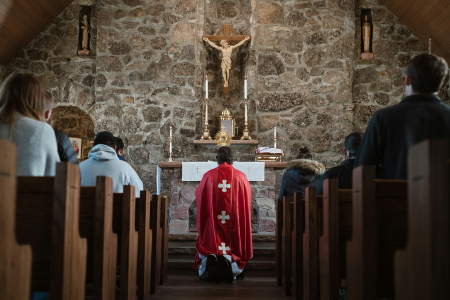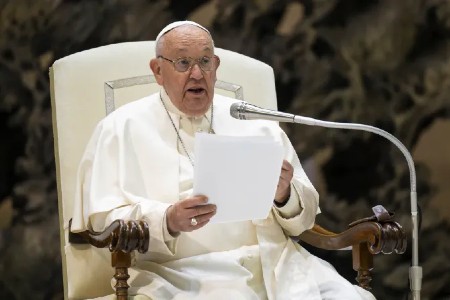Charles-François Gounod
FREE Catholic Classes
One of the most distinguished French musicians and composers of the nineteenth century, b. in Paris, on 17 June, 1818; d. there, 17 October, 1893. His father, a painter and architect of some distinction and a man of high character and sensitive nature, died when Charles was still in his childhood, and his education devolved upon his mother, a gifted pianist, who used her talents to provide for her two sons, Charles and Urbain. Gounod was sent early to the Lycée Saint-Louis, where he was one of the best scholars. His musical gifts, strikingly apparent from his earliest childhood, were carefully developed by his mother. He received his first great musical impression at the age of thirteen, when his mother took him to hear Rossini's opera "Otello", the principal roles of which were presented by Malibran, Rubini, Lablache, and Tamburini, four of the greatest singers the world has ever heard. That same year he witnessed a performance of Mozart's "Don Juan" and was raised by it to a high pitch of enthusiasm. In fact Mozart remained Gounod's ideal throughout his career. Other works which he heard at this period and which left lasting effects upon his mind were Beethoven's Pastoral and Ninth Symphonies. Having taken his degree as Bachelier-ès-lettres at the Lycée, he was sent by his mother to the Conservatoire, where he entered the theory classes of Reicha and Lesueur. Subsequently he studied counterpoint and composition under Halévy and Paer, professors in the same institution.
In 1839 his cantata "Fernand" won for him the Grand Prix de Rome , carrying with it the privilege of a three years' sojourn in Rome and a year's travel in Germany at the expense of the Government. The stay in Rome was, for a young man like Gounod, with a mind receptive of general culture and a delicate artistic temperament, fruitful of results which remained with him for life. It was not alone the art works of the Christian Era which absorbed his attention, but the monuments of pagan antiquity seemed to draw him even more powerfully. The great works of classic polyphony which he heard, Sunday after Sunday, in the Sistine Chapel undoubtedly left an indelible impression upon Gounod's imagination and memory ; still he does not seem to have penetrated to the life from which they sprang and the spirit which animated them, that is the spirit of the Church and her liturgy. This is easily accounted for when one considers that his favourite reading during this, the formative, period of his life was Goethe's "Faust" and the poems of Lamartine, and that the atmosphere in which he lived was not pronouncedly Christian. Throughout the greater part of the composer's career he seems to have been unable to rise above this dualism of principles and ideals. After leaving Italy, Gounod visited Vienna, where he wrote a requiem for chorus and orchestra and a mass a capella . Both works were performed under his direction in the church of St. Charles. In 1842 he returned to Paris and was soon appointed choirmaster at the church of the Missions Etrangeres, a position which he held for four years and a half. It was during this period that Gounod thought he had a vocation for the priesthood, and for two semesters attended the lectures on theology at the Seminary of Saint-Sulpice. In 1848 he resigned his position as choirmaster. This seems to have been the turning point in the young musician's career. In his autobiography he takes us into his confidence:
For a composer, there is but one road to follow in order to make a name, and that is the theatre [the operatic stage]. Thetheatre is the place where one finds the opportunity and the way to speak every day to the public; it is a daily and permanent exposition opened to the musician. Religious music and the symphony are certainly of a higher order, abstractly considered, than dramatic music, but the opportunities and the means of making one's self known along those lines are rare and appeal only to an intermittent public rather than to a regular public like that of the theatre. And then what an infinite variety for a dramatic author in the choice of subjects. What a field opened to fancy, to imagination, and to romance. Thetheatre tempted me. (pp. 166-67).Gounod's main activity was, from now on, directed towards the operatic stage.
We ask you, humbly: don't scroll away.
Hi readers, it seems you use Catholic Online a lot; that's great! It's a little awkward to ask, but we need your help. If you have already donated, we sincerely thank you. We're not salespeople, but we depend on donations averaging $14.76 and fewer than 1% of readers give. If you donate just $5.00, the price of your coffee, Catholic Online School could keep thriving. Thank you.Help Now >
The subjects he chose for his compositions, and which he successfully interpreted, were not calculated to preserve in his heart and mind the conditions requisite for an adequate interpretation of liturgical texts. His music allied to the poetry of Emile Augier, Jules Barbier, and Michel Carré, who acted as his librettists at various times, became the most powerful and the most widely diffused expression of French Romanticism in its more lyrical, sentimental form. It was, in deed, rather the lyric, sentimental side of such works as Goethe's "Faust', Shakespeare's "Romeo and Juliet", Corneille's "Polyeucte" which he seized upon than their heroic or metaphysical aspects. Among the operatic works which have made Gounod's name famous throughout the musical world are to be mentioned: "Sapho" (1851), "La nonne sanglante" (1854), "Le médecin malgré lui" (1858), "La reine de Saba" (1862), "Mireille" (1864), "La Colombe" (1866), "Roméo et Juliette" (1867), "Cinq Mars" (1877), "Polyeucte" (1878), "Le tribut de Zamora" (1881). The Franco-Prussion War caused Gounod to abandon Paris and reside in London for several years. After his return in 1875, he devoted himself more and more to religious music. In 1882 he brought out his oratorio "The Redemption ", for which he himself wrote the text and which he styled opus vitae meae . Three years later, in 1885, appeared "Mors et Vita", his last great work, the text for which he selected from Holy Scripture . In spit of Gounod's activity in the operatic field he never ceased writing to liturgical texts. His compositions of this character are numerous and varied. His "Messe Solennelle de Sainte-Cécile", "Messe de Pâques", "Messe du Sacré Coeur", and "Messe des Orphéonistes" have enjoyed great vogue in France, Belgium, England, and the United States. The mass in honour of Joan of Arc and the one in honour of St. John Baptist de la Salle are less widely known than the first three mentioned. Although these two works come nearer to the spirit of the liturgy than any of the earlier masses, nevertheless they bear the general character of all his compositions for the church. Gounod was a child of his time and of the France of the nineteenth century. His temperament, emotional to the point of sentimentality, his artistic education and environment bound him to the theatre and prevented him from penetrating into the spirit of the liturgy and from giving it adequate musical interpretation.
Join the Movement
When you sign up below, you don't just join an email list - you're joining an entire movement for Free world class Catholic education.
-

-
Mysteries of the Rosary
-
St. Faustina Kowalska
-
Litany of the Blessed Virgin Mary
-
Saint of the Day for Wednesday, Oct 4th, 2023
-
Popular Saints
-
St. Francis of Assisi
-
Bible
-
Female / Women Saints
-
7 Morning Prayers you need to get your day started with God
-
Litany of the Blessed Virgin Mary
U.S. Catholic Parishes Experience Resurgence of Traditional Practices
-

Pope Francis Urges Faith and Prayers for Peace
-

Florida Welcomes Volunteer Chaplains to Public Schools
-
10 Fascinating Details About St. Joseph the Worker: Celebrating His Feast Day - May 1
-
St. Joseph the Worker: Model for Men, Young and Old
Daily Catholic
 Daily Readings for Thursday, May 02, 2024
Daily Readings for Thursday, May 02, 2024 St. Athanasius: Saint of the Day for Thursday, May 02, 2024
St. Athanasius: Saint of the Day for Thursday, May 02, 2024 The Our Father: Prayer of the Day for Thursday, May 02, 2024
The Our Father: Prayer of the Day for Thursday, May 02, 2024- Daily Readings for Wednesday, May 01, 2024
- St. Marculf: Saint of the Day for Wednesday, May 01, 2024
- To Saint Peregrine: Prayer of the Day for Wednesday, May 01, 2024
![]()
Copyright 2024 Catholic Online. All materials contained on this site, whether written, audible or visual are the exclusive property of Catholic Online and are protected under U.S. and International copyright laws, © Copyright 2024 Catholic Online. Any unauthorized use, without prior written consent of Catholic Online is strictly forbidden and prohibited.
Catholic Online is a Project of Your Catholic Voice Foundation, a Not-for-Profit Corporation. Your Catholic Voice Foundation has been granted a recognition of tax exemption under Section 501(c)(3) of the Internal Revenue Code. Federal Tax Identification Number: 81-0596847. Your gift is tax-deductible as allowed by law.









 Daily Readings for Thursday, May 02, 2024
Daily Readings for Thursday, May 02, 2024 St. Athanasius: Saint of the Day for Thursday, May 02, 2024
St. Athanasius: Saint of the Day for Thursday, May 02, 2024 The Our Father: Prayer of the Day for Thursday, May 02, 2024
The Our Father: Prayer of the Day for Thursday, May 02, 2024


